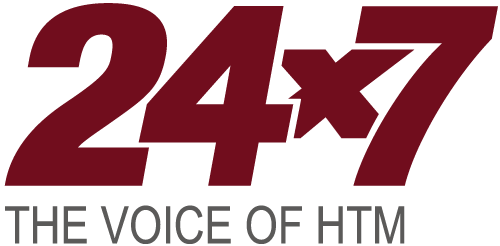A breakdown of the trends and challenges that defined the year and how they’re setting the stage for HTM in 2026.
As the end of 2025 nears, leading voices in healthcare technology management (HTM) reflect on the innovations, challenges, and evolving responsibilities shaping the field.
Dan Miles, vice president of information technology at Intelas; Marley Pritchard, vice president of client experience and strategy at Intelas; Pat Rice, president of US and Canada services at GE HealthCare; TJ Kubricky, vice president of product and portfolio management at TRIMEDX; Rick Joslin, senior solutions architect at FSI; and Andrew Yamarick, general manager of medical technology management at Agiliti, share their perspectives on the year’s defining technologies and pressures—and offer guidance on where HTM professionals should focus as they head into 2026.
What is the most impactful new innovation to enter the HTM space in 2025?
Miles: In 2025, the biggest shift in HTM is the rise of intelligent, connected platforms that unify HTM, cybersecurity, and capital planning into a single decision-support framework. These innovations move beyond traditional service management by combining real-time device performance data, lifecycle analytics, and cybersecurity monitoring to enable predictive maintenance, risk scoring, and proactive decision-making.
Rice: Generative AI and predictive maintenance tools have significantly helped HTM teams automate diagnostics, reduce downtime, and improve equipment lifecycle management. Generative AI enabled HTM teams to simulate device behavior, generate maintenance protocols, and even assist in documentation. Predictive maintenance used real-time data and machine learning to anticipate equipment issues before they occurred, helping to reduce downtime and improve patient safety.
Kubricky: AI-enabled device analytics and the maturation of network-connected medical device ecosystems stand out. Generative and agentic AI help eliminate fragmented systems and shift operations from reactive break/fix to proactive, risk-based management with continuous performance monitoring. Remote diagnostics now allow issues to be anticipated and resolved before downtime occurs. As devices become increasingly network-connected, capabilities such as real-time telemetry, firmware updates, anomaly detection, and root-cause analytics are gaining traction. The integration of AI, machine learning, and data science positions HTM as a central enabler of safe, secure operations—ensuring model integrity, version control, and firmware security.
HTM is also becoming more integrated with enterprise IT, cybersecurity, and operations through unified platforms for device health and analytics. This transformation is especially important amid workforce shortages and rising costs, as it helps providers and technicians be more productive, focus on meaningful work, and turn medical equipment into strategic assets for health systems.
Joslin: In 2025, AI has given a glimpse of possible uses that could directly impact how services are provided by HTM technicians, from analytics to utilization, distribution, and procurement activities. AI has the potential to provide repair technique suggestions to the technician, ensuring higher-quality corrective actions and reducing the learning curve of repair.
Yamarick: Several key trends are reshaping the industry: equipment engineered to fit broader, more diverse patient populations; caregiver-friendly technology that reduces physical strain on healthcare workers; integrated monitoring and connectivity with electronic medical record systems that enable real-time data capture, and more. These innovations are improving outcomes—but they’re also introducing new challenges for HTM teams.
As the technology becomes more advanced, HTM teams will need to adopt new approaches to preventive maintenance and service planning. Equipment uptime, documentation, and lifecycle management are becoming central to patient safety and operational success. The most effective HTM teams will be those that stay ahead of these trends—ensuring devices are not only functional but also ready when needed.
Key Takeaways: Sources agree that 2025 marks a turning point for HTM, driven by AI, predictive maintenance, and unified intelligence platforms that integrate cybersecurity, asset management, and capital planning. These technologies are moving HTM from reactive repair work to proactive, data-driven decision-making—improving equipment uptime, safety, and financial performance.
What was the most significant challenge HTM teams faced this year?
Pritchard: Many HTM teams faced simultaneous pressure: end-of-life equipment backlogs, rapid connectivity growth, and heightened cybersecurity expectations—without proportional budget expansion. The most effective response was to operationalize data-driven capital planning: unifying HTM, clinical, and finance around real asset performance and operational risk, using executive dashboards and a consistent scoring model to rank needs and time replacements/refreshes across the lifecycle. This moved decisions from “project by project” to a portfolio view that balances patient safety, uptime, and fiscal discipline.
Rice: Staffing shortages and supply chain delays caused many challenges for teams this year. Many organizations responded by training in-house technicians and using alternative suppliers to reduce costs and wait times. These dual pressures strained HTM departments across hospitals and health systems. Staffing shortages led to increased workloads and delayed service requests. Many organizations responded by cross-training clinical engineers and investing in internal development programs. Supply chain delays affected the availability of parts and new equipment, prompting some HTM teams to source from alternative vendors and refurbish existing assets to extend usability.
Kubricky: Teams are grappling with three major challenges: rising cybersecurity risks from increasingly connected devices, resource and talent shortages, and healthcare costs that continue to outpace reimbursement. As devices become more software-driven and networked, maintaining security and operational integrity becomes more complex. Budget pressures and staffing constraints are pushing HTM teams to adopt tools that boost productivity and provide real-time insights. Automation, RTLS, remote monitoring, and AI models are being integrated into workflows to streamline operations, enable predictive maintenance, and improve device availability. These technologies also support revenue generation by reducing downtime and ensuring devices are ready for billable procedures.
Joslin: Although cybersecurity continues to be a challenge to HTM departments, I think the guidance on Medical Device Servicing issued by the US Food and Drug Administration (FDA) in 2024 is starting to impact the industry negatively. Although medical equipment is manufactured and certified to OEM specifications, HTM technicians are trained to ensure it is safe to use and meets or exceeds those OEM specifications while the equipment is in their EOC.
As OEM materials continue to increase in price while decreasing in availability, it’s often difficult to maintain devices using those OEM materials, leading to the use of non-OEM materials that still meet and/or exceed OEM specifications. For example, using a non-OEM battery that provides the specified output yet provides longer output (higher mAh rating) could trigger an FDA event simply because the OEM specified a maximum mAh rating of 2600. Although in its infancy, this new guidance could chill internal repair activities, increase costs, and require larger inventories.
Yamarick: With this year’s record-breaking flu season and increase in chronic care patients, HTM teams grappled with even fewer critical resources and persistent staffing shortages. These constraints led to backlogs in preventive maintenance and delayed repairs for essential medical devices. As healthcare systems prepare for another demanding flu season, these capacity constraints are expected to persist. In response, teams turned to trusted third-party service partners. These providers act as an extension of the hospital’s own team, alleviating operational burden by providing supplemental staffing and medical equipment, maintenance support, compliance reporting, and more to ensure continuous patient care.
Key Takeaways: HTM teams faced mounting pressure in 2025, driven by staffing shortages, supply chain challenges, aging fleets, and rising cybersecurity risks. Leaders responded by cross-training teams, adopting data-driven capital planning, partnering with external service providers, and integrating automation and remote monitoring to stay ahead of demand and maintain device readiness.
How did the role of HTM evolve in 2025?
Pritchard: HTM matured from a primarily service/maintenance function to a central orchestrator of connected-device strategy—bridging clinical operations, cyber risk, and long-range capital planning. Teams leaned into shared dashboards, common risk taxonomies, and lifecycle governance to drive enterprise-level tradeoffs. Looking to 2026, that trajectory persists: tighter alignment with finance, broader device standardization initiatives, and elevated expectations for data fluency (analytics, risk scoring, and decision support) within HTM leadership and front-line roles.
Rice: HTM roles have often expanded to include cybersecurity, AI integration, and remote device support. Many teams became more cross-functional, and new roles like AI analysts and workflow automation specialists emerged. Many HTM professionals took on broader responsibilities as technology became more integrated and complex. AI integration required new roles like AI analysts and data engineers to support smart devices. Remote device support allowed technicians to troubleshoot and update equipment virtually, reducing on-site visits and improving response times.
Kubricky: The role of HTM evolved from being primarily technical fixers to strategic partners contributing to enterprise decisions through data-driven insights. HTM teams became more integrated with IT, cybersecurity, and informatics, aligning with broader infrastructure and cloud strategies. New roles emerged requiring advanced skills in technologies like real-time location systems (RTLS), computerized maintenance management systems, remote monitoring, analytics platforms, and AI automation, along with expertise in firmware, software, cybersecurity, and interoperability. HTM also gained greater executive visibility, influencing decisions around capital investments, operational performance, and clinical strategy. Looking ahead to 2026, this evolution is expected to accelerate, with HTM becoming more embedded in digital and clinical operations and enterprise architecture.
Joslin: Medical equipment continues to evolve technologically, and new capabilities and skills are needed. Clinical engineering has evolved from an electronics-based skill set to a multi-disciplinary requirement. Technicians now need experience in electrical engineering, software, renewable energies, and interpersonal skills management. When adding in the expansion of home-based medical care, it’s not unusual for a technician to help a patient with proper wiring and safety instructions while also supporting the need to report unsafe conditions to proper channels.
Yamarick: The role of HTM expanded to a strategic business level in 2025. HTM teams have proven crucial in assessing new technologies and directing investments that support hospital growth, working with clinical, IT, and operational leaders. Responsibilities grew beyond equipment maintenance to include technology evaluation, risk management, and strategic development, positioning HTM teams as key players in achieving hospital objectives.
However, this evolution occurred against a backdrop of significant challenges: Healthcare facilities face unprecedented pressure from aging equipment fleets, increased equipment volumes, and a shortage of qualified biomed technicians. In fact, the US Bureau of Labor Statistics is projecting a need for more than 76,800 medical equipment repairers by 2034. To maintain pace, facilities are increasingly adopting hybrid service approaches that combine in-house staff for critical equipment with contracted support for high-volume devices.
Key Takeaways: In 2025, HTM advanced from a maintenance-focused role to a strategic partner within healthcare organizations. Sources noted growing collaboration with IT, cybersecurity, and finance, the rise of data-driven decision-making, and the emergence of new roles centered on AI, analytics, and remote support. HTM professionals are now shaping enterprise strategy, guiding technology investments, and driving operational efficiency across connected, digital health ecosystems.
What shifts did you observe this year in how HTM teams approach risk?
Pritchard: Organizations increasingly codified risk—using standardized, data-backed scoring to prioritize remediation and replacement, and surfacing that view to executives via real-time dashboards. Cyber considerations for connected devices are now embedded alongside safety and reliability when planning spend or approving add-on initiatives, with defined intake/approval paths to maintain alignment and traceability across regions and leadership. This has strengthened compliance posture while accelerating decisions on high-impact risks.
Rice: We’re seeing HTM teams take a more proactive approach to risk management, using AI to detect threats and adopting stricter compliance protocols. Risk management became a shared responsibility across departments. Risk management evolved from reactive to proactive, with HTM teams leading the charge. AI tools were deployed to monitor device networks for anomalies and potential threats. Compliance protocols were tightened, and risk management became a shared responsibility across IT, clinical, and administrative departments.
Kubricky: In 2025, HTM teams significantly evolved their approach to risk, expanding beyond reactive responses to embed proactive risk governance into daily workflows. Cybersecurity became a major focus, with teams implementing preemptive firmware management, anomaly detection using machine learning, and stronger network segmentation strategies. Dynamic risk scoring frameworks helped prioritize oversight of high-impact devices, while collaboration with cybersecurity teams and OEMs improved transparency around vulnerabilities and patching.
On the patient safety front, HTM began monitoring AI model drift, sensor degradation, and device performance trends to anticipate failures before they occurred. Predictive maintenance, strategic decommissioning, and integrated data from RTLS and scheduling systems supported safer, more efficient device management. Teams also responded more quickly to recalls and adverse event reports, feeding insights into inventory and lifecycle planning.
Joslin: Changes in the regulatory landscape have forced HTM teams to forego all assumptions about normality, safety, and risk when managing their medical equipment. Assuming a current medical device in the inventory has been secured could lead to a breach. Understanding the language, protocols, and software needed to ensure cyber compliance requires additional training and (often) certifications. Risk assessments, once a one-and-done activity, are becoming part of any maintenance or service activity to ensure the device is clear of PHI, PII, current antivirus, and remote access are all reviewed and compliant with organizational and regulatory requirements. In turn, this leads to a higher hours count per service ticket and will impact productivity.
Yamarick: For years, risk management in healthcare was often compartmentalized, with clinical technology risk handled by HTM, IT risk by the IT department, and compliance by a separate legal or compliance office. Today, organizations are no longer debating whether to integrate their risk strategies, but rather how to—and at what speed. Equipment serviceability and lifecycle management have also become central to reducing vulnerabilities and strengthening resilience. Equipment that is maintained to the highest quality standards throughout its entire lifecycle keeps devices patient-ready while minimizing risk exposure.
Key Takeaways: In 2025, HTM teams redefined risk management—shifting from reactive fixes to proactive, data-driven governance. Sources highlighted tighter integration with IT and cybersecurity, widespread use of AI for threat detection and anomaly monitoring, and standardized risk scoring to guide capital and compliance decisions. Risk management became an enterprise-wide responsibility, embedding cyber, safety, and reliability considerations into every stage of the equipment lifecycle.
What emerging trends, tools, or approaches have the potential to shape HTM workflows in the near future most significantly?
Pritchard: The next wave centers on platformization and decision intelligence. Expect continued adoption of integrated solutions that join inventory/asset performance with cyber exposure and budget planning—plus configurable scoring models that adapt to system priorities. Executive-level views will become routine for portfolio steering, while HTM teams leverage analytics to predict service needs, schedule lifecycle events, and drive standardization to reduce variation and total cost of ownership.
Rice: Several trends helped HTM teams streamline operations and reduce costs. Predictive maintenance reduces unplanned downtime and extends equipment life. Telehealth device support enables remote monitoring and servicing of patient-facing devices. Vendor-agnostic service models allow HTM teams to service equipment from multiple manufacturers, increasing flexibility. And workflow automation tools improve ticketing, scheduling, and documentation processes.
Kubricky: One major shift is the dynamic integration of device data—such as RTLS location, network activity, and utilization—into AI models and automation platforms, enabling more comprehensive and predictive device management. Standardized device health APIs and open data-sharing frameworks are also gaining traction, making it easier to connect device insights with hospital analytics and EHR systems. Augmented reality tools are improving maintenance efficiency by offering visual guidance and remote support overlays, while AI assistants are helping technicians diagnose issues, generate reports, and streamline vendor coordination. Sustainability is becoming a key consideration, with HTM teams increasingly factoring in reuse, refurbishment, and circular lifecycle planning.
Joslin: Cybersecurity and network awareness continue to grow in the industry, requiring technicians to gain skills and understanding of both technologies. Ensuring a connected medical device can consume network traffic and is on the correct network means knowing where those settings are, how each device’s setting affects connectivity and traffic, and how security software will interact with device traffic. Transitioning to home-based medical care, technicians may be tasked with setting up connected devices on home networks or establishing a home network using mobile network technologies.
Yamarick: HTM workflows are gradually evolving due to operational, cultural, and organizational shifts. Integrated governance will be central to this change, replacing siloed decision-making with a cross-functional approach to technology policy and risk. This can be complemented by strategic vendor management, moving beyond cost-focused procurement to a value-based assessment and incorporating long-term service requirements.
Key Takeaways: Experts predict that platformization, AI-driven analytics, and integrated governance will most significantly shape HTM workflows in the coming years. Sources highlighted tools such as predictive maintenance, workflow automation, augmented reality, and open data frameworks that connect device, network, and utilization insights. As HTM becomes more data- and connectivity-focused, success will depend on cross-functional collaboration, cybersecurity expertise, and value-based vendor partnerships.
What should HTM professionals be preparing for as we head into 2026?
Pritchard: By 2026, connected-device cyber posture will be inseparable from capital strategy. Systems that can quantify operational and cyber risk at the asset category level—and tie that to lifecycle plans, standards, and budgets—will move fastest and spend smarter. HTM leaders should prioritize clean, decision-grade data; consistent scoring; cross-functional governance; and staff development in analytics and risk communication to lead that convergence.
Rice: Looking ahead, HTM professionals should prepare for AI-powered automation in diagnostics, maintenance, and inventory management; emotional AI in patient-facing devices, requiring new ethical and technical considerations; heightened cybersecurity demands as devices become more connected and intelligent; and upskilling in AI, data analytics, and cybersecurity will be needed to stay ahead.
Kubricky: One of the most critical trends HTM professionals should prepare for is the accelerating convergence of AI/machine learning (ML) technologies and cybersecurity risk. Medical devices are increasingly powered by AI models for diagnostics, anomaly detection, and decision support, which introduces new responsibilities for HTM teams to ensure these models remain valid, secure, and uncorrupted over time. The attack surface is expanding to include threats like model poisoning, adversarial inputs, and firmware vulnerabilities, requiring HTM to develop proficiency in algorithmic risk mitigation.
Transparency from vendors around model updates, software dependencies, and patching practices will become essential. HTM teams must also adopt more rigorous oversight of AI-enabled devices, integrating cybersecurity frameworks and collaborating closely with IT and security teams. This shift marks a move beyond traditional mechanical and electrical maintenance into a more complex, software-centric risk landscape.
Joslin: ML will likely impact how devices are maintained by incorporating more predictive activities that replace traditional calendar-based ITM activities. Coupled with network connectivity, a device could predict an imminent failure (due to low battery, increase in ground leakage, reaching specified use hours, an IV bag getting too low) and notify one or more individuals that action is needed. Moving from a scheduled inspection, testing, and maintenance strategy to a predictive/reactive one will challenge the clinical engineering team in areas of workload distribution, equipment management, performance metrics, and compliance documentation.
Yamarick: The rising complexity of technology, growing interconnectivity, and the need for tighter integration of clinical and cybersecurity functions may create challenges for HTM professionals. They will likely have to manage the immense convergence of technical, operational, and external challenges within the highly interconnected medical device ecosystem.
Additionally, HTM departments may need to contend with potential operational and resource constraints, which include a widening talent gap straining in-house capabilities for everything from analytics and cybersecurity to the maintenance of increasingly complex equipment. HTM leaders should remain ready by forming solid partnerships and using service models that enhance their abilities while simultaneously prioritizing quality and patient safety in every choice.
Key Takeaways: As 2026 approaches, HTM professionals should prepare for deeper convergence between AI, cybersecurity, and capital planning. Sources emphasized the need for clean, decision-grade data; stronger governance and analytics skills; and readiness for AI-driven maintenance, predictive ITM, and algorithmic risk oversight. Success will hinge on cross-functional collaboration, upskilling in data and cybersecurity, and adopting service models that balance efficiency, safety, and resource constraints.
Editor’s note: Responses have been lightly edited for clarity and length.
ID 405529367 | 2025 Review © Olan Dah | Dreamstime.com





